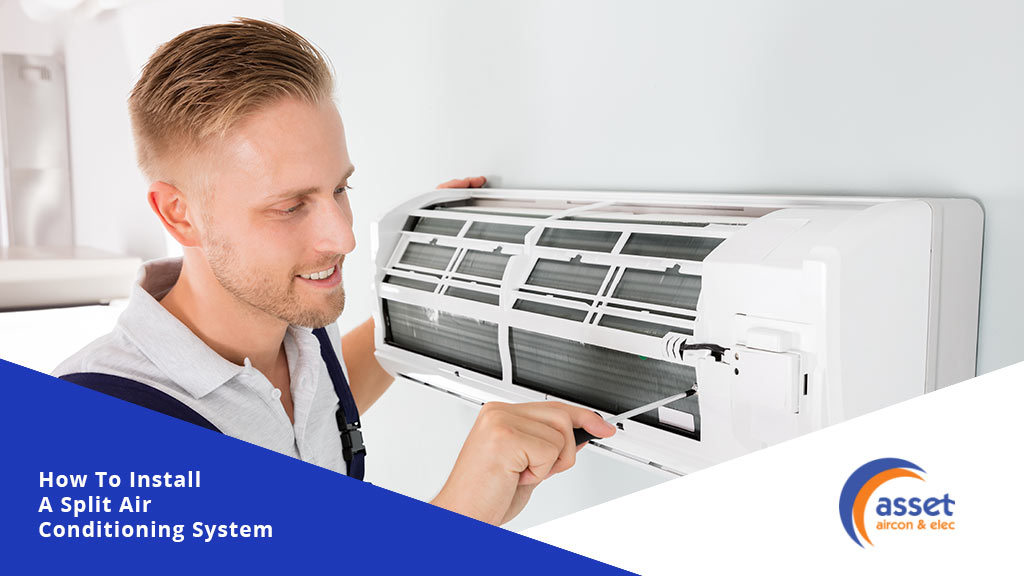Prioritising your indoor room temperature and the quality of breathable air are essential factors to consider in your home. With more professionals working from home, deciding what air conditioner to install in your bedroom, lounge, or open area can improve your work productivity, health, and sleep quality. A study conducted at the University of Denmark found that good quality air can improve productivity by 10%, while sleeping your air conditioner assists you with regulating your body temperature on hot and humid summer nights and colder winter temperatures.
No doubt, fitting an air conditioner into your home is an investment. Not only will you improve comfort levels but also scale your property value or validate higher chargeable rental income from tenants who are looking for well-ventilated and quality indoor air for their living and workspaces.
Why choose to install a split air conditioning system?
Firstly, split-type air conditioners are easy and cost-effective in the long run. When considering the benefits, it is easy to understand why so many couples choose a split system for their main bedrooms and why new mothers insists on fitting their baby nursery rooms with a 2.5kw reverse cycle air conditioner.
If you live in Gold Coast, Tweed Rivers, or Brisbane, reverse cycle air conditioners adapt perfectly from summer to winter. They come with custom-built design features to save electricity with every change of season.
Basically, a reverse cycle air conditioner cools your living spaces in summer and warms them in winter. Reverse cycle systems absorb the heat from the outdoor air to warm the inside rooms, unlike conventional heaters that create heat energy to achieve the same result, but with an added running cost factor.
It is super easy to use an air conditioner in winter and summer. All you have to do is remember to switch the remote control from heating to cooling in the summer months. The science behind air conditioners allows your reverse cycle split system to draw heat from the outside, then mix that same hot air into a cocktail with a refrigerant that later passes over an external coil. The cooling process continues as the refrigerant gas pumps through a compressor into a fan coil unit inside the indoor unit to release crisp cool air temperatures into your living spaces.
Before installing an air conditioner, we need to understand the anatomy of a split air conditioning system. By understating the basics of how a split system works, you will easily spot a quality install and ultimately reduce running costs over the years to come.
Let’s start by uncloaking our split system. It is fascinating to consider the parts that make up a split air conditioner system like any anatomy lesson.
A few key organs remain constant, be it a ducted system, split system, or multi-split system.
Let’s start:
The Evaporator, more commonly referred to as the coil in the indoor unit, needs the refrigerant to flow through it to work. The outdoor fan draws hot air over the evaporator coils in hot summer conditions and drives it back into the indoor unit to dispel a much lower indoor temperature. The refrigerant then absorbs the heat and transforms a liquid into a gas.
The Compressor, the heat that assembles inside the air conditioner, travels through insulated copper piping in the outdoor unit, mainly to compress the low-pressure refrigerant gas into a high-pressure refrigerant gas. The hot air that is not needed then deploys to the outside atmosphere.
The Condenser unit, is in the outdoor unit, it consists of a second coil that receives the hot, compressed refrigerant gas. The refrigeration cycle is repeated with the aid of a second fan. This fan disperses the heat to the external atmosphere.
The Expansion valve is the final key to unlock the refrigerant cycle! The expansion valve regulates the refrigerant flow into the evaporator. The entire process repeats over and over to meet perfect indoor temperature requirements.
What types of refrigerants do we get, and are they good for the environment?
We often marvel at the ability of refrigerants to transform between gas and liquid states without any fuss.
The most commonly used refrigerants used today are R32 and R410A.
R32 is the better option for the environment with much lower global warming potential therefore, it is essential to check the gas in your new split system air conditioner.
What type of split installations is the best?
A few installation options are available, depending on your space, the split air conditioner dimensions, features, and budget. Installation pricing varies depending on optional extras such as:
- Wall brackets for the Outdoor unit
- Roof brackets for the Outdoor Unit
- Extra refrigeration piping for more extended length installation (other than a Back to Back)
- Extra piping in Ducting
We prefer to make use of a sturdy wall bracket; however other options are available for example, the outdoor unit can be positioned on concrete, poly slab, or feet.
Here are a few most common installation methods used for Gold Coast Air conditioning home installations
- Back to Back Installation
- Up and Over Installation
- Double Storey installation
- Apartment or Unit installation
- Short Stump House installation
Back to Back Installation:
This is a relatively basic and cost-effective installation technique, the indoor unit is mounted on the wall with the interconnected cooling pipes running through the wall and connected to the outdoor unit, which is positioned directly below the indoor unit.
The two units are therefore back-to-back. This installation method is ideal for bedrooms or small office spaces.

Up and Over Installation:
This type of installation is
slightly more involved, the indoor unit is mounted on an internal wall the interconnecting cooling pipes run through the ceiling cavity and over to where the outdoor unit is mounted on the outside.
This type of installation is suitable to cool a room in the front or middle of a house. At Asset Aircon & Elec, the outdoor unit’s aesthetically pleasing and less intrusive positioning is far more awarding than walking away from a job with an unsightly condenser unit spoiling the frontal of a home.
The refrigeration pipes that connect the outdoor unit to the indoor unit runs up through the ceiling cavity in the house to where the outdoor unit is mounted externally.
This installation suits split installations at the front or middle of the house, with the outdoor unit discreetly mounted out the back or side of the house for an aesthetically pleasing, less intrusive installation.

Double Storey Installation
This type of installation is similar to a Back to Back installation but generally requires additional interconnected refrigerant piping and wall-mounted brackets for the outdoor unit.

Apartment or Unit Installation:
This type of installation can be tricky; depending on the High-rise location and specifications, you may need to budget for specialised height and rigging costs to install your air conditioner safely. Other restrictions to consider are the noise levels of the outdoor unit and the proximity to your neighbour’s living and sleeping spaces. Most people find it easier to speak to us or to have a sales engineer come out for a free quotation.

Short Stump House Installation
This type of installation makes provision for installations that require extra interconnected refrigeration piping on a standard back-to-back installation due to a particular building style of a home. Typically applicable to a Queenslander home where the outdoor unit is located on a concrete slab or feet under the home.

Noise factors to take into consideration when installing a split air conditioner?
Let’s face it, we all need to keep our neighbours happy.
Keeping your neighbour sound asleep at night is a must; therefore, keep your condenser unit as far away from your boundary wall or fence as possible.
Noise levels are measured from the fence or the boundary wall between your property and your neighbour’s property.
Choosing the quietest air conditioner possible and keeping it as far away from surrounding houses or apartments may save an on-the-spot fine.
Queensland follows the Environmental Protection Act 1994 that stipulates the allowable noise limits of air conditioners.
So between 7 am and 10 pm noise levels are not be louder than 5db(A) above background noise and between 10 pm and 7 am not louder than 3db (A) above background noise.
Here are a few handy tips to keep in mind when planning your installation.
Keeping outdoor units closer to the ground allows fences and walls to serve as sound screens, thereby minimising the sound that can travel through the boundary wall. On the other hand, outdoor units installed on slabs or brackets (preferred by most air conditioner manufacturers) should have adequate clearance space and anti-vibration mounts.
Another handy tip when choosing a location of the unit is to allow for a noise level increase over time as the unit’s performance deteriorates from wear and tear and the vibration increase, and the fans and compressors go out of balance.
Although with a regular preventative maintenance plan, these issues can be addressed to allow minimum noise level increases over time.
For all your split, multi-split, and ducted air conditioning installation needs, give our team a call on (07) 5596 1033. We are keen to help









